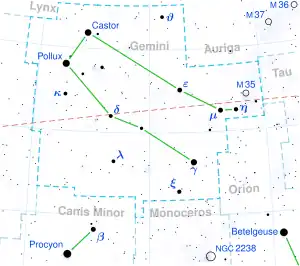北河三
北河三,即雙子座β星(β Geminorum,縮寫為β Gem),是一顆位於雙子座,距離太陽約34光年,已經演化呈現橙色色調的巨星。它是最接近太陽的巨星。
 北河三在雙子座中的位置。 | |
| 觀測資料 曆元 J2000.0 | |
|---|---|
| 星座 | 雙子座 |
| 星官 | 北河 (井宿) |
| 赤經 | 07h 45m 18.94987s[1] |
| 赤緯 | +28° 01′ 34.3160″[1] |
| 視星等(V) | 1.14[2] |
| 特性 | |
| 演化阶段 | 巨星 |
| 光谱分类 | K0III[3] |
| U−B 色指数 | +0.86[2] |
| B−V 色指数 | +1.00[2] |
| 变星类型 | Suspected[4] |
| 天体测定 | |
| 徑向速度 (Rv) | +3.23[5] km/s |
| 自行 (μ) | 赤经:–626.55[1] mas/yr 赤纬:–45.80[1] mas/yr |
| 视差 (π) | 96.54 ± 0.27[1] mas |
| 距离 | 33.78 ± 0.09 ly (10.36 ± 0.03 pc) |
| 绝对星等 (MV) | +1.08±0.02[6] |
| 詳細資料 | |
| 質量 | 1.91±0.09[7] M☉ |
| 半徑 | 8.8±0.1[8] R☉ |
| 表面重力 (log g) | 2.685±0.09[8] |
| 亮度 | 43[9] L☉ |
| 溫度 | 4666±95[8] K |
| 金属量 [Fe/H] | –0.07 to +0.19[8] dex |
| 自轉 | 558 days[10] |
| 自轉速度 (v sin i) | 2.8[11] km/s |
| 年齡 | 724[12] Myr |
| 其他命名 | |
| 參考資料庫 | |
| SIMBAD | 资料 |
| ARICNS | 资料 |
自1943年迄今,這顆恆星的光譜是其它分類的依據標準之一[14]。在2006年,發現它有一顆行星,被命名為北河三b(β Gem b),並已確認它的軌道[8]。
恆星性質
依巴谷天文測量衛星[15][16]以視差測得它與太陽的距離大約是33.78光年(10.36秒差距) [1]。
.jpg.webp)
北河三的視星等為1.14等[17],在亮星表中,它比同星座的北河二(雙子座α)還要明亮。北河三和太陽相比,質量約為太陽的2倍[7],直徑約為太陽的9倍[8]。北河三原本是一顆A型主序星[18],但已經耗盡了核心的氫燃料,並演化成為光譜類型為K0III的巨星 [3]。這顆恆星外面殼層的有效溫度大約是4666 K[8],位於K型恆星呈現橙色色調的範圍內 [19]。北河三的投影轉速是2.8 km•s−1[11]。除了氫和氦之外的其他元素豐度,也就是金屬的豐度,估計範圍從太陽的85%至155%不等,還沒有正確的數值[8][20](需要注意的是天文學家所說的金屬,是指氫和氦之外的所有其他元素)。
軌道上的倫琴衛星(ROSAT)探測到微弱的X射線輻射,這是北河三有低水準磁活動的證據。來自這顆恆星的X射線輻射大約是1027 erg s−1,大約與來自太陽的相等。已經證實北河三的表面磁場強度低於1高斯,這是在恆星上發現的最微弱磁場之一。磁場的存在表明,北河三曾經是一顆具有更強磁場的Ap星[18]。恆星的徑向速度有小振幅的變化,但不是光度學上的變化 [21]。
行星系統
自1993年起,科學家就測量到徑向速度的振盪,因而懷疑北河三有行星環繞著[22]。在2006年6月16日證實並宣布它有一顆行星。計算出北河三b的質量至少是木星的2.3倍,環繞北河三的周期大約是590日[8]。
| 成員 (依恆星距離) |
质量 | 半長軸 (AU) |
轨道周期 (天) |
離心率 | 傾角 | 半径 |
|---|---|---|---|---|---|---|
| b | >2.30 ± 0.45 MJ | 1.64 ± 0.27 | 589.64 ± 0.81 | 0.02 ± 0.03 | — | — |
參考資料
- 資料
- van Leeuwen, F., , Astronomy and Astrophysics, November 2007, 474 (2): 653–664, Bibcode:2007A&A...474..653V, arXiv:0708.1752
 , doi:10.1051/0004-6361:20078357
, doi:10.1051/0004-6361:20078357 - Ducati, J. R. . CDS/ADC Collection of Electronic Catalogues. 2002, 2237: 0. Bibcode:2002yCat.2237....0D.
- Morgan, W. W.; Keenan, P. C., , Annual Review of Astronomy and Astrophysics, 1973, 11: 29–50, Bibcode:1973ARA&A..11...29M, doi:10.1146/annurev.aa.11.090173.000333
- Petit, M., , Astronomy and Astrophysics Supplement, October 1990, 85 (2): 971, Bibcode:1990A&AS...85..971P (法语).
- Famaey, B.; et al, , Astronomy and Astrophysics, January 2005, 430 (1): 165–186, Bibcode:2005A&A...430..165F, arXiv:astro-ph/0409579
 , doi:10.1051/0004-6361:20041272
, doi:10.1051/0004-6361:20041272 - Carney, Bruce W.; et al, , The Astronomical Journal, March 2008, 135 (3): 892–906, Bibcode:2008AJ....135..892C, arXiv:0711.4984
 , doi:10.1088/0004-6256/135/3/892
, doi:10.1088/0004-6256/135/3/892 - Hatzes, A. P.; et al, , Astronomy & Astrophysics, July 2012, 543: 9, Bibcode:2012A&A...543A..98H, arXiv:1205.5889
 , doi:10.1051/0004-6361/201219332, A98.
, doi:10.1051/0004-6361/201219332, A98. - Hatzes, A. P.; et al, , Astronomy and Astrophysics, 2006, 457: 335–341, Bibcode:2006A&A...457..335H, arXiv:astro-ph/0606517
 , doi:10.1051/0004-6361:20065445
, doi:10.1051/0004-6361:20065445 - Mallik, Sushma V., , Astronomy and Astrophysics, December 1999, 352: 495–507, Bibcode:1999A&A...352..495M
- Koncewicz, R.; Jordan, C., , Monthly Notices of the Royal Astronomical Society, January 2007, 374 (1): 220–231, Bibcode:2007MNRAS.374..220K, doi:10.1111/j.1365-2966.2006.11130.x
- Massarotti, Alessandro; et al, , The Astronomical Journal, January 2008, 135 (1): 209–231, Bibcode:2008AJ....135..209M, doi:10.1088/0004-6256/135/1/209
- Takeda, Yoichi; Sato, Bun'ei; Murata, Daisuke, , Publications of the Astronomical Society of Japan, August 2008, 60 (4): 781–802, Bibcode:2008PASJ...60..781T, arXiv:0805.2434
 , doi:10.1093/pasj/60.4.781
, doi:10.1093/pasj/60.4.781 - , SIMBAD (Centre de Données astronomiques de Strasbourg), [2012-01-14], (原始内容存档于2020-01-24)
- Garrison, R. F., , Bulletin of the American Astronomical Society, December 1993, 25: 1319 [2012-02-04], Bibcode:1993AAS...183.1710G, (原始内容存档于2019-06-25)
- Perryman, M. A. C.; Lindegren, L.; Kovalevsky, J.; et al, , Astronomy and Astrophysics, July 1997, 323: L49–L52, Bibcode:1997A&A...323L..49P
- Perryman, Michael, , Astronomers’ Universe (Heidelberg: Springer-Verlag), 2010, Bibcode:2010mhgs.book.....P, doi:10.1007/978-3-642-11602-5
- Lee, T. A., , Astrophysical Journal, October 1970, 162: 217, Bibcode:1970ApJ...162..217L, doi:10.1086/150648
- Aurière, M.; et al, , Astronomy and Astrophysics, September 2009, 504 (1): 231–237, Bibcode:2009A&A...504..231A, arXiv:0907.1423
 , doi:10.1051/0004-6361/200912050
, doi:10.1051/0004-6361/200912050 - , Australia Telescope, Outreach and Education (Commonwealth Scientific and Industrial Research Organisation), December 21, 2004 [2012-01-16], (原始内容存档于2012-03-10)
- The abundance is determined by taking the value of [Fe/H] in the table to the power of 10. Hence, 10−0.07 = 0.85 while 10+0.19 = 1.55.
- Henry, Gregory W.; et al, , The Astrophysical Journal Supplement Series, September 2000, 130 (1): 201–225, Bibcode:2000ApJS..130..201H, doi:10.1086/317346.
- A. P. Hatzes; et al. . The Astrophysical Journal. 1993, 413: 339–348. Bibcode:1993ApJ...413..339H. doi:10.1086/173002.
- 文獻
- Hatzes; et al. . The Astrophysical Journal. 1993, 413: 339–348 [2007-12-10]. (原始内容存档于2019-12-11).
- Hatzes; et al. . Astronomy and Astrophysics. 2006, 457: 335–341 [2020-10-02]. (原始内容存档于2009-05-01).
- Reffert; et al. . The Astrophysical Journal. 2006, 652: 661–665.
外部連結
| 维基共享资源上的相关多媒体资源:北河三 |
- . ARICNS. [November 21, 2005]. (原始内容存档于2005年9月4日).
- Extrasolar planet confirmed around β Geminorum
- Precise Radial Velocities of Giant Stars II. Pollux and its Planetary Companion(页面存档备份,存于)
- . The Extrasolar Planets Encyclopaedia. [2008-06-24]. (原始内容存档于2008-06-01).
- . SolStation. [2005-11-21]. (原始内容存档于2012-02-18).
- Sabine Reffert; et al. . Astrophys. J. 2006-07-07, 652 (1): 661–665 [2014-03-30]. Bibcode:2006ApJ...652..661R. arXiv:astro-ph/0607136
 . doi:10.1086/507516.
. doi:10.1086/507516.